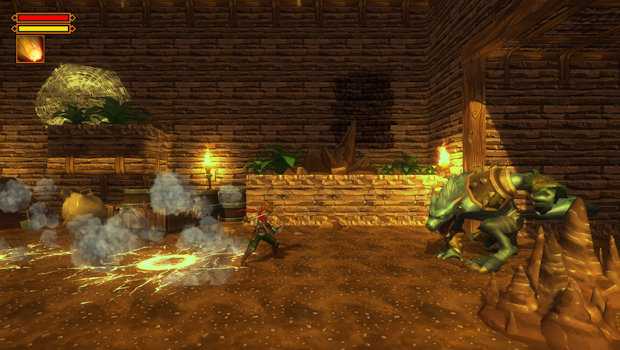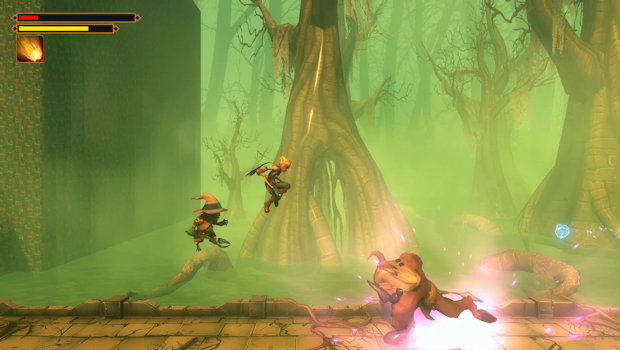I love a lot of different types of games but 2D-action platformer is probably up there as my favorite genre. As such, the new indie-platformer The Forbidden Arts drew me to it as soon as I heard about it.
The world of The Forbidden Arts is a bit generic. As Phoenix, you are a young pyromancer who sets out on a quest, which like any quest in a game like this, eventually becomes about saving the world as we know it. Weirdly, the quest starts out in a 3D world, very small, closed off, and without much populating it other than a couple NPCs, a handful of gold bars, and spots to bring you elsewhere. The elsewhere is where the real game takes place and the real game is a 2D side-scroller.
The Forbidden Arts is segmented in to a handful of levels that are massively built. This is both great and sometimes incredibly frustrating. It’s great because most of the levels are massive with tons to explore. But it is also incredibly frustrating because the field of view for the game is actually very narrow. Often times, you can’t see what you need to see, especially above and below you. There is a slight expansion of view where you can look up or down but it doesn’t increate it enough in most cases, which can often leave you wondering what you are to do next. The game attempts to alleviate the issue by providing a mini-map that can give a bit more detail but with crevices often being very deep, you don’t realize you shouldn’t have jumped down that hole until you are already dead. Aimlessness and lack of knowledge for encounters is a problem I found the game to have a bit too much of.
After the first couple levels, I often found myself wandering around trying to figure out what the game wants me to do. And this isn’t just a me problem, in my frustration I attempted to find somebody who might have completed the area I was in and watch a video of them and each of the videos I found featured the same problems I was facing. Eventually they stumbled across the solution but that’s not good design, that’s luck and in a skill-based genre like an action-platformer, the game shouldn’t have so much relying on luck. I’m not saying that you can’t encourage players to explore, but there is a way to do it and for it to feel natural and there is a way to do it and make everything super frustrating. More often than not, The Forbidden Arts chooses the frustrating way.
It doesn’t help that the game seems designed at times to punish you with trial and error problems. From jumps that have to be timed just right, but not right as in how you’d think because the game has a weird delay in button presses so timed right to the input lag, to boss fights that don’t give you any indication of how to beat them so you just bang your head against a wall over and over and over. It’s not fun.
And I know I probably sound like a cranky old man whose skill has diminished but I played through The Messenger last year. I played a good chunk of Dead Cells and Hollow Knight. Those games aren’t easy but they relay information to the player in a way that is valuable and while you might fail a couple times fighting them, it never felt cheap. Certain fights in The Forbidden Arts just feel unfair. You’d think if you were just granted a power, that you’d use that in some way to defeat the next level, and particularly the boss but often this isn’t the case. And until you stumble across the solution, or solutions as many fights often have multiple phases, you are clueless to how to proceed. There doesn’t seem to be a logical flow to how these encounters are designed.
These are big problems, at least for me. It doesn’t matter that the game actually looks pretty good and the powers are mostly fun when you get to use them. It doesn’t matter that the voice acting is solid, or the massive levels have a great amount of secrets to uncover. And it doesn’t matter that there is a solid amount of enemy variety and they are fun to engage with. Because even though that stuff is important, fundamental aspects of the game just don’t work.
Fortunately the developer seems to be listening to the feedback and making good smart changes. For instance, when I played the game for review, Phoenix could suffer fall damage which made some of the trickier platforming areas extra dangerous if you flubbed a jump because health recharges aren’t plentiful and seem to be random. But the dev removed fall damage after feedback. They also fixed some achievement bugs that were glitching my receipt of the one for finishing the game. If they (or he, I believe there is only one programmer on this game), clean some of this up, it could make for a fun little indie title. Right now though, I’d be hard pressed to recommend it to anyone.
This article was written with material provided from the developer for the Xbox One. For more on our review process, please read here.


